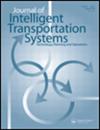自动驾驶车辆与普通车辆混合共用的最佳车道分配策略
IF 2.8
3区 工程技术
Q3 TRANSPORTATION
Journal of Intelligent Transportation Systems
Pub Date : 2025-03-04
DOI:10.1080/15472450.2024.2307027
引用次数: 0
摘要
自动驾驶技术有可能改变我们的出行方式,并且正在迅速发展。在未来,共享自动驾驶汽车可能会成为一种流行的公共交通方式。本文章由计算机程序翻译,如有差异,请以英文原文为准。
Optimal lane allocation strategy for shared autonomous vehicles mixed with regular vehicles
Autonomous driving technology has the potential to alter the way we travel and is rapidly evolving. Sharing rides in autonomous vehicles may become a popular mode of public transportation in the future. One strategy to enhance operational efficiency is to deploy designated autonomous vehicle (AV) lanes for shared autonomous vehicles (SAVs). This study investigated optimal allocation for dedicated AV lanes considering mixed SAVs and regular vehicles (RVs) flows. First, the standard bottleneck model for morning rush hour was extended to account for both ridesharing and automation, and user equilibrium (UE) solutions were obtained by assuming dedicated AV lanes co-exist with general-purpose (GP) lanes. The equilibrium capacity allocation for dedicated AV lanes was determined for multi-modal traffic scenarios. The study found that commuters may prefer to use SAVs because SAVs were more cost-effective and time-saving. Furthermore, analysis of the fixed payment for ridesharing in SAVs revealed that the system performance could be negatively impacted by high fixed payments. The study proposed an enumeration algorithm for developing lane strategies for discrete lane settings. It was found that the deployment of dedicated AV lanes should be matched to the penetration rate of SAVs and different management objectives, following a gradual rather than a radical process. Finally, a sensitivity analysis was performed considering the value of travel time for SAVs and the bottleneck capacity of a dedicated AV lane. This work provides a new solution to AV lane capacity allocation and offers theoretical support for managers to deploy dedicated AV lane allocation.
求助全文
通过发布文献求助,成功后即可免费获取论文全文。
去求助
来源期刊
CiteScore
8.80
自引率
19.40%
发文量
51
审稿时长
15 months
期刊介绍:
The Journal of Intelligent Transportation Systems is devoted to scholarly research on the development, planning, management, operation and evaluation of intelligent transportation systems. Intelligent transportation systems are innovative solutions that address contemporary transportation problems. They are characterized by information, dynamic feedback and automation that allow people and goods to move efficiently. They encompass the full scope of information technologies used in transportation, including control, computation and communication, as well as the algorithms, databases, models and human interfaces. The emergence of these technologies as a new pathway for transportation is relatively new.
The Journal of Intelligent Transportation Systems is especially interested in research that leads to improved planning and operation of the transportation system through the application of new technologies. The journal is particularly interested in research that adds to the scientific understanding of the impacts that intelligent transportation systems can have on accessibility, congestion, pollution, safety, security, noise, and energy and resource consumption.
The journal is inter-disciplinary, and accepts work from fields of engineering, economics, planning, policy, business and management, as well as any other disciplines that contribute to the scientific understanding of intelligent transportation systems. The journal is also multi-modal, and accepts work on intelligent transportation for all forms of ground, air and water transportation. Example topics include the role of information systems in transportation, traffic flow and control, vehicle control, routing and scheduling, traveler response to dynamic information, planning for ITS innovations, evaluations of ITS field operational tests, ITS deployment experiences, automated highway systems, vehicle control systems, diffusion of ITS, and tools/software for analysis of ITS.

 求助内容:
求助内容: 应助结果提醒方式:
应助结果提醒方式:


